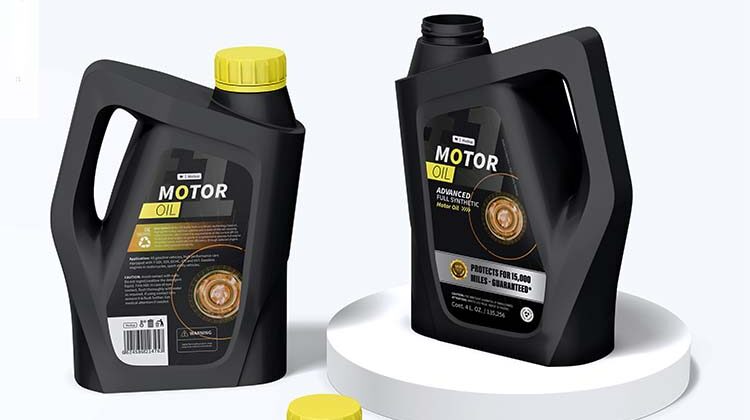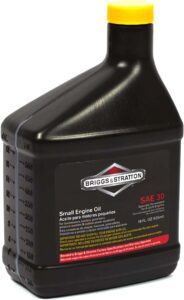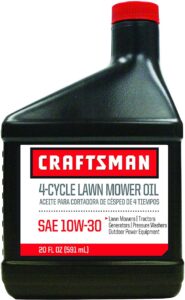
The appropriate kind of oil should always be used when replacing or topping off the engine’s oil because it is its lifeblood. The oil grading system enters the picture here. Although it might appear unclear at first, the Society of Automotive Engineers (SAE) classifies motor oil according to a very distinct pattern.
The viscosity/weight (or ease of flow) of the oil is used to grade it. The ratings range from 0 to 60, with 0 representing the least viscous (thinnest) oils and 60 representing the most viscous (thickest) oils. Though they share a rating, the difference between SAE 30 and 5w30 is not as clear-cut as it may first appear.
What is SAE 30 OIL?
The SAE class under which the engine oil was categorized is called SAE 30. These monograde oils are primarily utilized above the freezing point. SAE 30 oils do not have good cold flow properties. Use them only in spring, summer, and fall. The viscosity rating of the SAE 30 oil is 30, making it a single grade of oil. A multi-grade oil, such as 10W-30, is rated for both SAE 10W and SAE 30, whereas this is not the case.

A single grade of oil may be graded for either a hot viscosity grade or a cold-start viscosity grade (in which case the grade will be denoted by the letter “W,” which stands for Winter). The winter-grade viscosity in a multi-grade oil simulates the engine cranking at low temperatures.
Only hot viscosity is rated for SAE 30 oil. This rating reflects the motor oil’s viscosity at 100OC operating temperature (212OF).
Why is this important?
Viscosity is directly impacted by temperature. Beyond a certain temperature, an engine will begin to overheat, and the motor oil will start to degrade due to thermal breakdown. As extended engine life depends on adequate engine lubrication, you should avoid doing this.
Next, let’s examine the applications for SAE 30 motor oil.
SAE 30 will always be an excellent choice if chilly weather is not a concern. The thicker oil will help to protect the older sections of the car, making it a suitable choice even if it is an older model.
What is 10w30?
Engine oil with the designation 10W30 has a viscosity rating of 10W when the engine is cold and 30W when the engine is hot. This is distinct from oil with a 5W30 designation, which has a thinner viscosity when the engine is cold.
How 10w30 Oil Affects Equipment
Although understanding oil viscosity is crucial for effective fleet maintenance, it also has an impact on a variety of industrial equipment’s performance. Viscosity, for instance, can alter how much heat is produced by cylinders and bearings. Viscosity can also influence how quickly oil is used up and how simple it is to start and run equipment in extremely hot temperatures. You will use less oil and your vehicles or equipment will last longer if the oil has a greater viscosity or is thicker in warm weather.

However, using oil with lower viscosity can help machinery start-up more smoothly and use less gasoline. Inappropriate oil viscosity may occasionally cause mechanical components to come into contact.
You’ll start encountering equipment damage and issues if this is left unchecked. As a result, it’s crucial to include routine oil changes in your preventative maintenance program in addition to choosing the appropriate type of oil for each application
When To Use 10w30?
10w30 will be a preferable option if the weather is unpredictable or the winters are very harsh
Difference between SAE 30 and 10w30
Both SAE 30 and 10w30 motor oils are recommended. While 10w30 is ideal for varying temperatures or year-round use, SAE 30 is appropriate for older vehicles and people who reside in warmer climates. There are a lot of similarities and significant changes that could affect how they function for your car.
No, The viscosity is where these two oils diverge the most. That implies that they behave uniquely in response to changes in temperature. SAE 30 is hefty. It won’t flow as quickly as the other one does. The 10w30 oil is thinner and has been tested at low temperatures in addition to performing similarly at higher temperatures.
SAE 30 and 10w30 Oil Differences Explored
These two goods share a lot of similarities; however, they are used very differently in many situations. Each of them has traits that make them more suitable for a particular task than the others.
SAE 30 vs 10w30 by performance
SAE 30 Oil
Most users of SAE 30 are satisfied with it. Even when exposed to high temperatures for an extended period, it will safeguard your engine while being slightly more expensive
10w30 Oil
For a long time, 10w30 performs admirably at high temperatures. When it is cold, it has poor viscosity as well. Because of this, those who reside in a region with a variety of climates should consider it. This might be the one for your car if you wear a sweater in the morning and then shorts in the afternoon. When it is cold, it won’t thicken up and prevent your engine from turning.
SAE 30 vs 10w30 by Composition
SAE 30 Oil
Many oils feature detergent ingredients that collect dirt and assist the engine to stay clear of sludge in the interim. Some automobile owners dislike detergents because they believe they damage their vehicles more than they help. If an oil is not marked as being detergent-free, you are probably purchasing one that is.
10w30 Oil
Both synthetic and conventional motor oils in the 10w30 range are available. Conventional fuels start with a base of crude oil and a few additives. Over time, synthetic oil tends to function better than those and safeguards the engine. Always remember to replace the oil filter with the oil. That will lessen the chance of additive buildup causing issues with your car in the future.
SAE 30 vs 10w30 by Pressure
SAE 30 Oil
Oil SAE 30 can resist considerable pressure. It has undergone extensive testing at high temperatures of up to 212°F.
10w30 Oil
Because 10w30 is thinner than SAE 30, it won’t exert as much pressure, extending the life of your engine.
SAE 30 vs 10w30 by Viscosity
SAE 30 Oil
The viscosity of SAE30 is rated as 30. This indicates that in warm or hot conditions, it flows adequately in the typical automobile or truck. It can withstand the engine’s growing temperature. Additionally, it will aid in shielding it from the friction that its moving parts produce.
10w30 Oil
In high temperatures, the viscosity of both oils is the same. The 10w30 will not thicken up as much as the other when the engine is cool. Additionally, 10w30 will circulate and speed up the start-up of your engine in cold conditions.
SAE 30 vs 10w30 by Operating Temperature
SAE 30 Oil
Hot viscosity has been assessed for SAE 30. There have therefore been no experiments to demonstrate its effectiveness, even though it may do so in your automobile in chilly conditions. It will break down once the engine temperature reaches 250–260°F but will achieve its viscosity peak at roughly 212°F. The engine will overheat after that. To continue, the oil must cool. The cold weather profile of SAE 30 is not ideal. It works best when used throughout the warmer seasons.
10w30 Oil
Up to 212°F, 10w30 is ideal in a hot engine. Like SAE 30, it will start to degrade at around 260°F. However, because it is thinner, it may survive in temperatures as low as 13°F. Therefore, it will enable a smooth restart and keep you operating over the winter.
SAE 30 vs 10w30 by Price
SAE 30 Average Price per Quart
Like with any product, the price is heavily influenced by the brand name. It could reveal a lot about the caliber as well. Make a cautious study if it’s created by a brand, you’ve never heard of. Some well-known brands charge between $10 and $15 for a quart of their products.
10w30 Average Price per Quart
One of the reasons why 10w30 is so popular is that it is reasonably priced. Many brands cost less than $5. Customers should prepare to pay between $5 and $10.
Should You Use SAE 30 or 10w30?
There is not a lot of difference between the two unless you will be in a colder climate. Because SAE 30 may be too thick for the parts in smaller engines, like lawnmowers, 10w30 will work well.
If your automobile is older, you might want to think about switching from SAE 30 to 10w30 as the weather starts to change and back again when it becomes cooler. This will allow you to take advantage of the lower viscosity in cold weather while still providing the moving parts of your engine with the protection that thicker oil provides.
Our Recommended SAE 30 and 10w30 Oil Brands
For SAE 30 oil, then the three top brands are:
For 10w30, you cannot go wrong with the following:
WHAT IS Lawnmower OIL WEIGHT?
Since the development of oil engines, the classification of motor oil based on motor oil weight has been a continuous endeavor. This is especially significant when considering how it applies to the automotive sector.
Choosing the proper formula for maximum efficiency has become crucial as engine performances are constantly improving. A motor oil classification system based on oil weight or viscosity was developed by the Society of Automotive Engineers (SAE) in collaboration with top engine manufacturers to aid in these efforts.
Lawn mower oil type recommendations
At temperatures, various oil kinds may perform well. Find out which one to select based on your climate
SAE 30: Warmer temps; most popular oil for small engines
SAE 10W-30 grade of oil aids cold-weather starting but may result in increased oil consumption due to its wide temperature range.
The synthetic Best protection at all temperatures and improved starting with less oil use are both features of SAE 5W-30.
SAE 5W-30 – Extremely chilly conditions.
Vanguard 15W-50 – Wide range of temperatures. For ongoing use, such as pressure washing or professional grass care
Lawn Mower Oil Capacity
Walk-behind lawnmowers:
The normal oil capacity is 15 oz. or 18 oz. Engine oil should be changed every 50 hours or once a year, whichever comes first.
Riding Mowers:
The normal oil capacity is 48 or 64 ounces*. Engine oil should be changed every 100 hours or once a year, whichever comes first.
Can you use synthetic lawn mower oil?
Yes! In all temperature ranges, you may now use a synthetic 5W30 (100074WEB) or 10W30 oil, according to changes we made to our engine oil recommendations. The usage of Briggs & Stratton Synthetic Oil is advised. By using this premium detergent oil, Briggs & Stratton warranty conditions on the use of the right oil are met.
Synthetic oil engine break-in procedures stay the same. Remember that using synthetic oil does not preclude you from doing your routine annual maintenance on your lawn mower (i.e. check oil, change oil, etc.).
Four-cycle engine vs. Two-cycle engine
Some compact push mowers have a two-cycle engine in contrast to the majority of walk-behind and riding mowers, which all use four-cycle engines. A four-cycle engine needs two revolutions of the crankshaft and piston to draw fuel and air into the cylinder, ignite it, and then exhaust the combustion gases, whereas a two-cycle engine only needs one revolution to accomplish the same task. How oil should be added differs significantly between the two engine types. A separate sump serves as the engine’s oil supply, and a four-cycle engine receives gasoline from a fuel tank. Oil and gasoline must be combined for a two-cycle engine to run.
For a two-cycle engine to function effectively, the oil and gasoline must be combined. This can be challenging since running a two-cycle engine without the right oil and gas mixture would result in the engine seizing from a lack of lubrication. Use a pre-mixed fuel and oil product like TRUFUEL 50:1 Mix to fill the tank if you’re worried about getting the gas/oil balance perfect for a two-cycle engine.
A four-cycle lawn mower engine needs to be maintained similarly to a car engine because it has a separate sump for the oil, which means the oil needs to be changed frequently.
How frequently should I change the oil?
The frequency of use of the lawn mower determines how frequently you should change the oil. The oil should permanently be changed annually, just before the cutting season begins. However, it is advised that you change the oil in your walk-behind mower after fifty hours of use if you frequently mow your lawn, maintain the lawns of numerous neighbors, or own a lawn maintenance company. You should change the oil in your riding mower or zero-turn mower every 100 hours of use, depending on the size of the job.
The method for changing the oil will vary depending on the type of mower you have and the engine model, but for the majority of walk-behind mowers, you can typically unthread the oil tank cap, remove the dipstick, if necessary, and carefully tip the mower to empty the old oil into an acceptable container. The majority of auto parts stores recycle engine oil, including that from lawnmowers. After emptying the oil tank, put the mower back in the upright position and fill the oil fill tube with fresh oil. Riding mower engines use 48 or 64 ounces of oil, whereas walk-behind mower engines typically use 15 or 18 ounces. Pour in roughly three-quarters of the bottle to avoid overfilling, then make sure
Conclusion:
The most crucial thing to keep in mind is that any oil is preferable to none at all. Both SAE 30 and 10w30 are excellent solutions for your car and will extend its lifespan. However, depending on the age of the car and the area where you are, make sure to obtain the oil that best meets your demands if you want optimum performance and a comfortable drive throughout the entire year.
FAQ’s
The performance of SAE 30 is optimized for heated conditions. As it warms up and travels through the hot engine, the oil becomes thinner after becoming thicker.
Both are appropriate for lawnmowers, yes. The SAE 30 will provide greater protection if your mower is more seasoned. The heavier oil may cause problems for some small engines. It is best to check your owner’s manual before switching the type of oil you are using with smaller engines.
Yes. Any SAE graded motor oil can be mixed
Leave a Reply